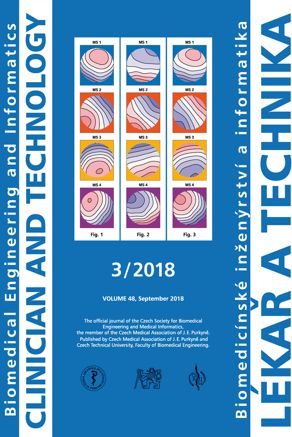EEG MICROSTATES ANALYSIS IN PATIENTS WITH EPILEPSY
Keywords:
EEG, Microstates, GFP, Epileptic activityAbstract
Analysis of EEG microstates is a promising topographical method that is currently being studied for diagnosis of neuro-psychiatric diseases such as schizophrenia, dementia, etc. The aim of our study is to describe the possibility of using the microstate analysis of electroencephalographic recordings (EEG) for examination of the epileptic activity. The EEG recordings were measured on patients with epilepsy and on control subjects (with no epileptic pathology) in the system 10 - 20. The data are analysed in average montage and filtered with bandpass from 0.5 to 30.0 Hz. We calculate the global field power (GFP) curve to extract microstates from the EEG recordings. We take local maxima (peaks) of GFP curve to create amplitude topographic maps. The microstate 1 seems to have higher occurrence for the non-epileptic controls than the patients with epilepsy. The duration of the microstate 4 seems to be higher in the epileptic patients than the non-epileptic controls. We have found that there is a significant difference in the duration, occurrence and contribution of the amplitude topographic maps between the non-epileptic controls and the patients with epilepsy.
Downloads
Published
Issue
Section
License
Copyright (c) 2019 Vaclava Piorecka, Marek Piorecky, Jan Strobl, Marie Nezbedova, Hana Schaabova, Vladimir Krajca

This work is licensed under a Creative Commons Attribution 4.0 International License.
Authors who publish with this journal agree to the following terms:
- Authors retain copyright and grant the journal right of the first publication with the work simultaneously licensed under a Creative Commons Attribution License (https://creativecommons.org/licenses/by/4.0/) that allows others to share the work with an acknowledgment of the work's authorship and initial publication in CTJ.
- Authors are able to enter into separate, additional contractual arrangements for the non-exclusive distribution of the journal’s published version of the work (e.g., post it to an institutional repository or publish it in a book), with an acknowledgment of its initial publication in this journal.
- Authors are permitted and encouraged to post their work online (e.g., in institutional repositories or on their website or ResearchGate) prior to and during the submission process, as it can lead to productive exchanges.
CTJ requires that all of the content of the manuscript has been created by its respective authors or that permission to use a copyrighted material has been obtained by the authors before submitting the manuscript to CTJ. CTJ requires that authors have not used any copyrighted material illegally, as for example a picture from another journal or book, a photo, etc. It is the author’s responsibility to use only materials not violating the copyright law. When in doubt, CTJ may ask the authors to supply the pertinent permission or agreement about the use of a copyrighted material.
The opinions expressed in CTJ articles are those of authors and do not necessarily reflect the views of the publishers or the Czech Society for Biomedical Engineering and Medical Informatics.


